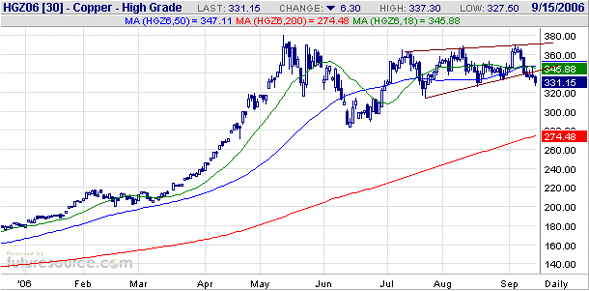|
|||
The coming industrial metals downturnSteve Saville
The following daily chart shows that December copper futures broke below a short-term trend-line last week. There is significant support in the 3.20s, but if this support gives way then a test of the June low (the 2.80s) will probably follow in fairly quick time.  Unlike the situation in the oil and natural gas markets, the aboveground supply of physical copper remains quite low relative to demand. The short-term risk in the copper market isn't that a moderately-tight supply situation will suddenly turn into a supply glut, but that the price will plunge in response to a mass exodus from commodity-related funds by the investors who piled into these funds over the past couple of years. Even if the commercial demand for copper remained at its current levels the copper price could quickly drop to $2.50, or even to $2.00, if the breaking of some technical support levels caused the money managers who have channeled more than $200B into commodity-linked funds to seriously question the "commodity super-cycle" thesis. On the positive side of the ledger, unless such a decline were accompanied by a significant reduction in demand it would be short-lived. It would, we think, create a wonderful short-term buying opportunity for investors in mining stocks and a good opportunity for 'hedged' copper producers such as Phelps Dodge to exit their short positions. The longer-term risk is that the combination of a recovery in the US$ and a substantial slowdown in global growth will create a bearish set of supply/demand circumstances for copper and the other industrial metals. We expect that the copper price will exceed this year's high before the end of the decade, but, as appears to be the case with oil, it's quite possible that the industrial metals will experience cyclical bear markets over the coming 6-12 months. In any case, regardless of what happens over the next several months it's important for investors to understand that the long-term bull markets in metals and the stocks of metal producers did not end earlier this year. Long-term bull markets don't end when the major stocks in the bull-market sector have valuations that are less than half the broad market's average valuation; they end after valuations in the bull-market sector reach huge premiums. Right now, the world's two largest miners of industrial metals -- BHP Billiton and Rio Tinto -- are being valued by the stock market at less than 10-times earnings; and even if we assume that the prices of industrial metals are going to be, on average, 30% lower over the coming year than they are right now, at their current share prices these companies will still earn enough money to keep their P/E ratios in single digits. Furthermore, many of the smaller metal-producing companies are trading at even lower valuations than the aforementioned majors. In other words, although the stocks of industrial metal producers would almost certainly trade at lower levels in response to a 6-12 month downturn in the prices of the metals, there doesn't appear to be scope for them to trade a LOT lower. This is because current share prices already discount much lower metal prices. Investors in these stocks should therefore be wary about getting too bearish at this time. The time to have done some selling was earlier this year when prices were spiking upward in spectacular fashion, not now that almost all of the speculative enthusiasm has been wrung-out of the market. On a related matter, if a significant economic slowdown is on the cards as far as the coming year is concerned then we are about to enter an extended period when gold-related investments will do much better than industrial-metal-related investments. Given that this IS our expectation (we perceive a significant economic slowdown to be the most likely intermediate-term outcome) we would emphasise the gold sector when making new investments. We would, however, maintain CORE positions in selected industrial metal shares, and if presented with the opportunity to buy a high-potential industrial metal share at a substantial discount to fair value we would seriously consider taking it. One reason for maintaining core exposure to the industrial metals is that the long-term bull market is almost certainly intact (even if prices are lower in 6 months time, they will probably be a lot higher 2 years from now). Another is that we don't KNOW what the future has in store, so our current less-than-sanguine economic outlook might not necessarily be prescient. The best we can do is weigh the relevant evidence -- in the case of the economic outlook, the signals being generated by the most reliable leading indicators -- with the aim of determining the highest-probability outcome. Unfortunately, the over-arching message currently being sent by leading economic signals is not definitive. The breakdowns in some commodities and the stocks of some major commodity producers might be signaling a substantial growth slowdown, but yield-spreads and credit spreads -- amongst the most reliable indicators of future economic performance -- are not YET warning that a 'rough patch' lies ahead. Furthermore, the performance of the broad stock market suggests that if there is going to be a slowdown it will be a minor one. In other words, it's too early to open up a can of gloom. Steve Saville Regular financial market forecasts and analyses are provided at our web site: We aren't offering a free trial subscription at this time, but free samples of our work (excerpts from our regular commentaries) can be viewed at: http://tsi-blog.com Saville Archives |
